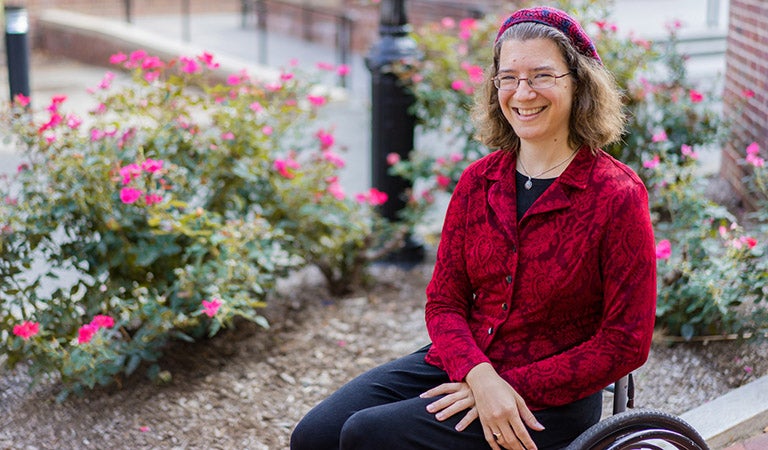Course Cluster Challenges Thinking on Disability

Professor Julia Watts Belser teaches a course on the intersection of disability and religion in the Georgetown University Disability Studies Course Cluster (photo by Alex Hu/Georgetown College).
September 14, 2016 — The Georgetown University Disabilities Studies Course Cluster is thriving in its second year, with seven classes offered this fall. It’s a broad and important field, but it isn’t exactly in the academic mainstream yet. So, what is disability studies, and how did this course cluster come to fruition?
Disability studies is an emerging field that critically analyzes the concept of disability across different cultures, time periods and academic disciplines. It raises challenging questions about the way we define physical and mental abilities, as well as the assumptions we make in designing and talking about our world.
Thanks to the efforts of English professor Libbie Rifkin and a team of faculty members over the last several years, the cluster offers a set of interconnected, interdisciplinary classes focusing on disability through numerous Georgetown College departments as well as the School of Nursing & Health Studies and the School of Medicine. Professors teach courses within their own disciplines but arrange events and collaborative exercises with other classes, all of which touch on the study of disability in some way.
A poetry specialist in the English department, Rifkin first became interested in disability studies when her son was born with cerebral palsy.
“As I began to think about our family’s experience in a broader sense, I became aware of this field, and of disability rights activism,” she said.
Rifkin began exploring disability in the classroom in 2008, offering first-year writing seminars that focused on the topic. Positive feedback from students encouraged her to offer electives, and before long other faculty members had expressed interest in collaborating.
One of those was Sylvia Önder, a professor of Turkish language and culture who had been examining disability-related issues — deaf culture, to be specific — through an anthropological lens.
“Deaf culture is an amazing linguistic community that’s not necessarily based on birth,” Önder said. “People think of hearing loss as meaning you’re ‘less than’ hearing people, but once you start deconstructing that, you get to really interesting results.”
Through Önder’s exploration of deaf culture arose an anthropology class taught in collaboration with a sociology class at Gallaudet University. Both groups took field trips to their counterpart’s campuses and participated in several in-class video conferences with interpreters on both sides.
“We found such fascinating things when two classes with two different languages in the same city came together to have a conversation,” Önder said.
Collaborative events like Önder’s field trips prove particularly effective in encouraging students to challenge the assumption of disability as an unusual obstacle rather than simply a part of human diversity. Often with support from the Red House, the course cluster has hosted events in which students have been able to interact with artists, scholars and community leaders in the disabled community.
Jennifer Natalya Fink, a professor of English and theater and performance studies, has extensively studied the art of the disabled community. For her class, attending performances — like wheelchair-using dancer Alice Sheppard, or environmentally ill performance artist Julie Laffin — has helped create a more complete picture of what disability means.
“We’re looking at disabled persons’ art not as inspiration-porn, but as art in and of itself,” Fink said. “And what makes art great — where creativity really happens — is not in an open field, but rather through negotiating limits. Part of disability entails confronting a limit, and that’s where the greatest innovation happens.”
Another important element of the disability studies course cluster is the theological lens.
Professor Julia Watts Belser, an ordained rabbi who studies classical Jewish texts and queer feminist Jewish ethics, teaches a course within the cluster that focuses on the intersection of disability and religion. Her class raises some of the most difficult and fascinating questions in the course cluster — no small feat, given the nature of the material.
“Some innovative and important impulses toward equal treatment of people with disabilities come out of religious sources,” said Belser, who is a wheelchair user. “On the other hand, ideas about the association between disability and sin, or of disability only as an object of charity, also emerge out of religious texts.”
Each professor teaching within the course cluster brings his or her own perspective through the lens of a specific academic discipline. But a few basic theses are quite visible in each of the courses: Definitions of ability vs. disability aren’t as black-and-white as they seem; disability is much more prevalent than most people realize; and active inclusion, not charity, is what disability rights activism seeks to achieve.
Last week, Rifkin delivered an eloquent version of this message in a presentation to Fr. Ray Kemp’s popular theology class, The Church and the Poor. She then played a video that showcased disability rights activists protesting on Washington, D.C.’s Memorial Bridge, and Fr. Kemp chimed in afterward:
“I think this should cause us to pause for a minute and look at a variety of sources, one of whom happens to be Jesus,” Kemp said. “He seemingly spends a whole lot of time with people that look like and sound like those folks coming across Memorial Bridge.”
— Patrick Curran